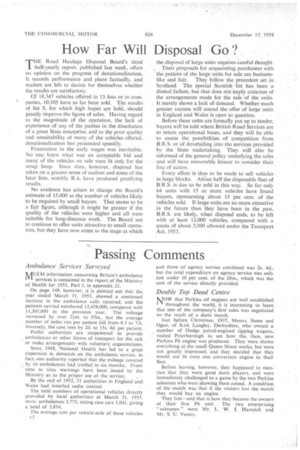How Far Will Disposal Go?
Page 40

If you've noticed an error in this article please click here to report it so we can fix it.
THE Road Haulage Disposal Board's third half-yearly report, published last week, offers no opinion on the progress of denationalization. It records performance and plans factually, and readers are left to decide for themselves whether the results are satisfactory.
Of 18,347 vehicles offered in 15 lists or in companies, 10,105 have so far been sold. The results of list 8, for which high hopes 4re held, should greatly improve the figure of sales. Having regard to the magnitude of the operation, the lack of experience of any of the parties in the dissolution of a great State enterprise, and to the poor quality and unsuitability of many of the vehicles offered, denationalization has proceeded speedily.
Frustration in the early stages was inevitable. No one knew what was an acceptable bid and many of the vehicles on sale were fit only for the scrap heap. Since then, however, disposal has taken on a greater sense of realism and some of the later lists, notably R.4, have produced gratifying results.
No evidence has arisen to change the Board's estimate of 15,000 as the number of vehicles likely to be required by small buyers. That seems to be a fair figure, although it might be greater if the quality of the vehicles were higher and all were suitable for long-distance work. The Board are to continue to offer units attractive to small operators, but they have now come to the stage at which the disposal of large units requires careful thought.
Their proposals for acquainting purchasers with the pattern of the large units for sale are businesslike and fair. They follow the precedent set in Scotland. The special Scottish list has been a dismal failure, but that does not imply criticism of the arrangements made for the sale of the units. It merely shows a lack of demand. Whether much greater success will attend the offer of large units in England and Wales is open to question.
Before these units are formally put up to tender, buyers will be told where British Road Services are to retain operational bases, and they will be able to assess the possibilities of competition from B.R.S. or of dovetailing into the services provided by the State undertaking. They will also be informed of the general policy underlying the sales and will have reasonable leisure to consider their line of action.
Every effort is thus to be made to sell vehicles in large blocks. AbOut half the disposable fleet of B.R.S. is due to be sold in this way. So far only 64 units with 15 or more vehicles have found buyers, representing about 15 per cent, of the vehicles sold. If large units are no more attractive in the future than they have been in the past, B.R.S. are likely, when disposal ends, to be left with at least 12,000 vehicles, compared with a quota of about 3,500 allowed -under the Transport Act, 1953.












































































































